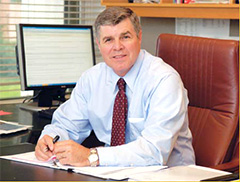Editorial
Making Connections, Finding Solutions
We can accomplish more, and make every dollar go farther, if we communicate and collaborate.

Robert H. Wiltrout, Ph.D. (Photo: B. Branson)
In our culture, tales of scientific discovery often celebrate a lone investigator—Archimedes in his bath or Newton under an apple tree—in a moment of epiphany. Indeed, many great leaps of innovation and discovery have been, and will continue to be, driven by creative individuals. Thus, the present day mechanisms for rewarding scientific performance place special emphasis on the individual, whether it is the first author of a paper or the invited guest lecturer. In reality, and as usually acknowledged by the individuals so distinguished, science is more often a collaborative effort.
At CCR, we are constantly looking for ways to encourage and reward collaborative science. Increasingly, the complexity of modern biomedical research requires skills and expertise that a single person simply cannot master in one lifetime. We recognize the need to build teams of scientists and clinicians that cut across traditional boundaries to solve the health problems we are facing.
As we learn in “Collaboration Reigns,” CCR is working across national boundaries on several projects with Thailand’s Chulabhorn Research Institute. A two-day symposium sponsored by CCR featured a visit by the Princess of Thailand, herself a research scientist as well as founder of the Chulabhorn Institute. Programs like the Collaborative Research and Graduate Partnership Program in Cancer Technology with the University of Maryland, described here in “Teaming Up to Fight Cancer,” are building bridges between academia and government scientists. And our Cooperative Research and Development Agreements (CRADAs) with industry continue to reap rewards (see “HIV Vaccine Strategy Is Not Dead”).
One factor that is not always noted in strategic discussions of team science, however, is the success that derives from the simple fun and passion of people working together to solve problems. Two articles in this issue of CCR connections tell the stories of NIH investigators who have enjoyed years of fruitful collaboration. In “Putting Heads Together,” Yardena Samuels, Ph.D., at NHGRI and Steven Rosenberg, M.D., Ph.D., at CCR describe their work on the genetics of melanoma. In “All in Good Fun,” CCR investigators Ira Pastan, M.D., and Michael Gottesman, M.D., talk about the inception of their pioneering work on the molecular basis of chemoresistance. As important as these scientists’ research accomplishments have been, the articles’ most striking revelation is the obvious pleasure that both men have derived from doing science in good company.
Sheue-Yann Cheng, Ph.D., notes in “The Interconnectedness of All Things” that science is not nine–to–five work and that the enjoyment of research is a necessary component of success. Cheng has developed mouse models with impaired thyroid hormone signaling that are the basis for multiple collaborations around the world to study physiological mechanisms underlying cancer, lipid metabolism, skeletal development, and more.
As Gabriela Kramer–Marek, Ph.D., describes in our “In Conversation” series, her work to visualize breast cancer and its metastases through positron emission tomography (PET) imaging has only approached fruition through the combined efforts of the chemists, physicists, and oncologists with whom she has worked at CCR and abroad. Collaborations not only reap scientific advances that would otherwise not be possible, they also train the next generation of scientists to solve problems together.


